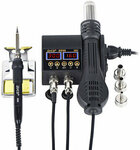This has been popular previously and it's back on sale. The AU$ exchange rate isn't quite as good as before but you can try stacking with cashback to save more. It also has an EU plug, however it's an IEC cable so you'll probably have one lying around.
- Apply the coupon BG13d921 at checkout
AU$ based on current Mastercard rate and shipping from AU warehouse.
Mod Note: US$30.67 delivered if your shipping address is affected by the no-free-shipping website bug.
Features:
- Hot air heater and welding iron 2in1 rework soldering station.
- Dual LCD digital displays to show precision temperature.
- Extremely low noise and space saving design.
- Intelligence self-detection function features safe personal operation.
- Automatic cooling function for effectively prolonging the heater's life and protecting the hot air heater.
Hot Air Heater:
- Working Voltage: AC220-240V OR AC100-130V
- Frequency: 50Hz/60Hz
- Output Power: 750W
- Temperature Range: 100°C~480°C
- Temperature Stability:±2℃
- Air Flow: 150L/min (max)
Soldering Iron:
- Working Voltage: AC220-240V OR AC100-130V
- Output Power: 80W
- Frequency: 50Hz/60Hz
- Temperature Range: 180°C-500°C
- Temperature Stability: ±1°C
- Soldering Iron : ESD design
- Heater Material : Ceramics




Is this any good? I only ask because I've had one blow up on me.